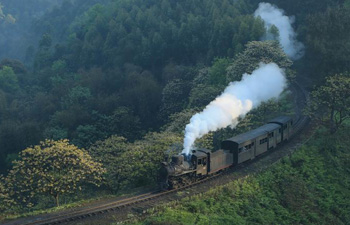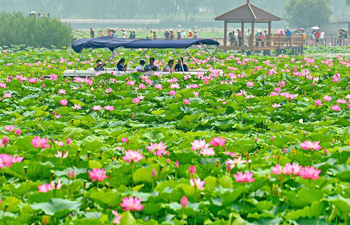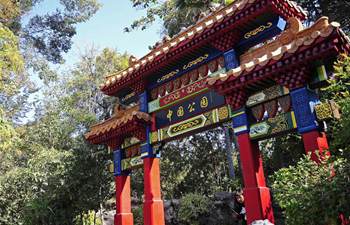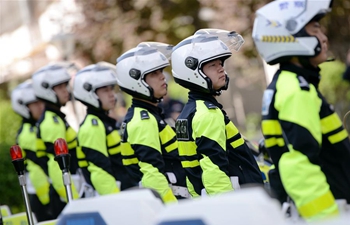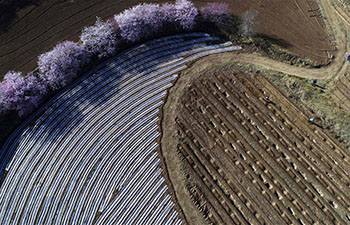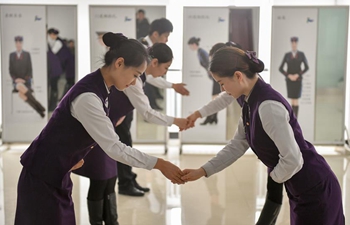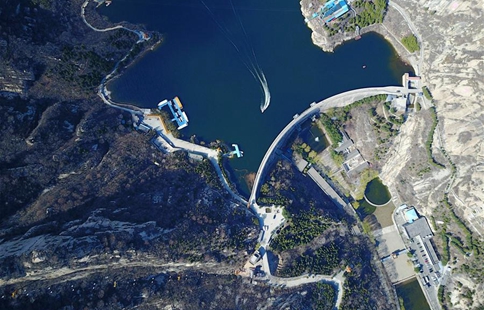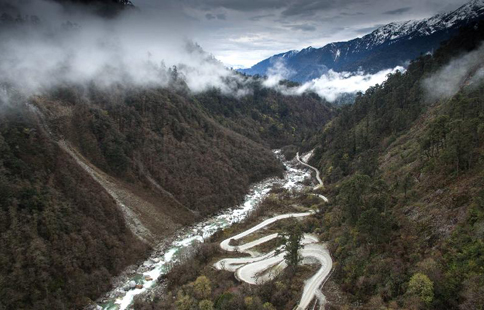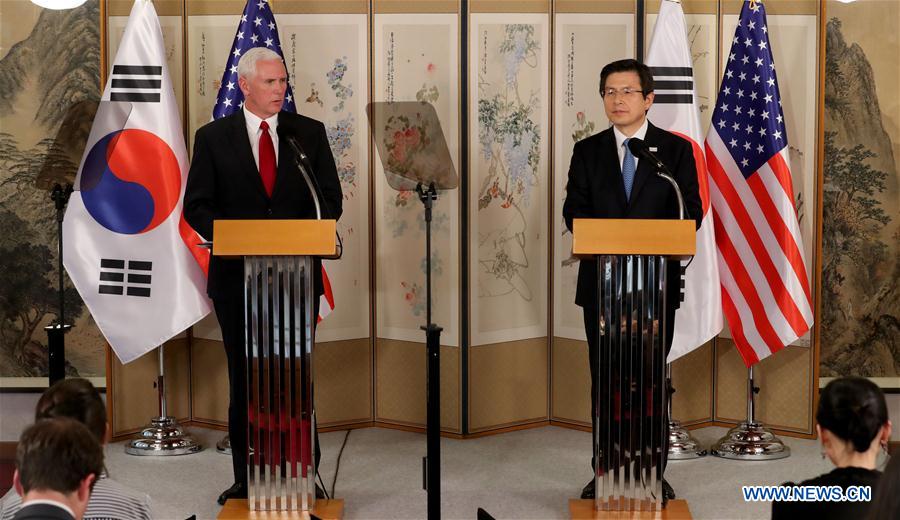
U.S. Vice President Mike Pence (L) and South Korean Prime Minister Hwang Kyo-ahn, who is serving as the acting South Korean president, attend a joint press conference in Seoul, South Korea, on April 17, 2017. Visiting U.S. Vice President Mike Pence said Monday that "an era of strategic patience is over" on the Democratic People's Republic of Korea (DPRK). (Xinhua/South Korean Action President and Prime Minister office-Pool)
SEOUL, April 17 (Xinhua) -- Visiting United States Vice President Mike Pence and South Korean Prime Minister Hwang Kyo-ahn agreed Monday to strengthen alliance of the two countries and take punitive actions on the Democratic People's Republic of Korea (DPRK).
Pence and Hwang, who is serving as the acting South Korean president, held talks in Seoul before having a televised joint press conference.
The U.S. vice president arrived in South Korea Sunday as part of a 10-day trip to Asia. Earlier in the day, Pence visited a U.S. base near the Demilitarized Zone dividing the two Koreas. He will leave for Japan on Tuesday.
Pence told reporters that the United States and South Korea have, since 1992, made joint efforts to achieve the denuclearized Korean Peninsula through peaceful means.
The U.S. vice president, however, said "all options are on the table" though the U.S. wants peaceful means for the denuclearization of the peninsula.
Citing two nuclear tests and multiple ballistic missile test-launches the DPRK conducted in the past 18 months, he said the "era of strategic patience is over" on the DPRK.
The strategic patience refers to a U.S. policy on the DPRK advocated by the previous Obama administration.
Pyongyang carried out its fourth and fifth nuclear detonations in January and September last year respectively. After the January atomic bomb test, the country launched a long-range rocket that put a satellite into orbit.
The rocket launch is seen by South Korea and the U.S. as a disguised test of a banned ballistic missile technology. The DPRK is banned from testing the technology under UN Security Council resolutions.
Shortly before Pence's arrival in South Korea, the DPRK test-launched an unidentified missile from its east coast. It exploded seconds after the launch, which was assessed by the South Korean military as a failed test.
Hwang said Pence's visit to South Korea was timely and meaningful as it came amid the mounting tensions in the region, which stemmed from what he claimed were the DPRK's nuclear and missile threats.
The acting president said he talked with Pence about the graveness and urgency of the DPRK's nuclear-tipped missiles, agreeing to thoroughly implement sanctions and pressure on the DPRK.
Hwang and Pence agreed to take punitive actions on the DPRK if the country conducts "further provocations."
The failed missile launch by the DPRK came amid rising tensions on the peninsula, which were caused by the rare re-routing of a U.S. aircraft carrier toward the West Pacific.
USS Carl Vinson aircraft carrier and its accompanying warships were approaching the peninsula. It was rare that the battleships participated in the ongoing U.S.-South Korea annual military exercises last month.
The U.S. vice president reassured its ally that the U.S. will "100 percent" stand with South Korea for secure future, saying the alliance between the two countries is a linchpin for peace and security in the peninsula and the Asia-Pacific region.
He issued a warning against the DPRK, saying Pyongyang should not mistake the resolve of U.S. President Donald Trump and the power of the U.S. forces stationed on the peninsula by conducting another provocations.
About 28,500 U.S. troops are stationed in South Korea, a legacy of the 1950-1953 Korean War that ended in armistice. The two Koreas are technically in a state of war.
Touching on the deployment of the Terminal High Altitude Area Defense (THAAD) missile defense system in South Korea, Pence said his country will continue to deploy the U.S. missile shield for the U.S.-South Korea alliance.
Seoul and Washington agreed in July last year to install one THAAD battery in southeastern South Korea. Two mobile launchers and other elements of THAAD were delivered last month to a U.S. military base in South Korea.
Pence described the THAAD deployment as a "defensive measure," but it caused strong oppositions from regional countries, including China and Russia, as it breaks strategic balance in the region and damages security interests of the two countries.




